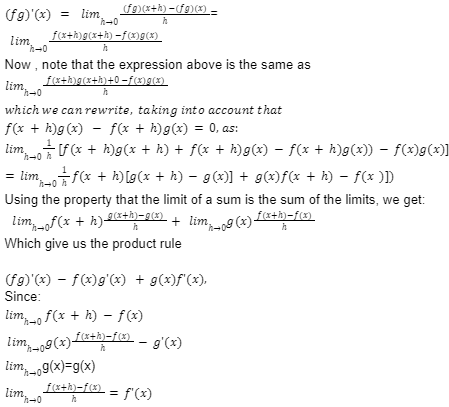Calculus employs the product rule to differentiate functions. The product rule is employed when a given function is the product of two or more other functions. If the issues are a combination of two or more functions, the Product Rule can be used to find their derivatives.Simply put, the term “product” refers to the combination of two functions that are multiplied together.
This rule, which was discovered by Gottfried Leibniz, allows us to calculate derivatives that we don’t want (or are unable to) multiply rapidly.
With another way of putting it, the product rule allows us to find the derivative of two differentiable functions that are multiplied together by combining our knowledge of both the power rule for derivatives and the sum and difference rule for derivatives.
It can be expressed as follows in simple terms: The second times the derivative of the first multiplied by the derivative of the first multiplied by the second times its own derivative equals the derivative of the second times its own derivative.
To demonstrate the product rule formula using the definition of derivative or limits, consider the function h(x) = f(x)g(x), which has the property that f(x) and g(x) are differentiable at the point x.
In calculus, the product rule is a method for determining the derivative of any function that is given in the form of a product produced by multiplying two differentiable functions. According to the product rule, the derivative of a product of two differentiable functions is equal to the sum of the product of the second function with differentiation of the first function plus the product of the second function with differentiation of the first function,the product of the differentiation of the first and second functions. That is, given a function of the form f(x)g(x), we may determine its derivative using the product rule derivative.
d/dx f(x)g(x) = [g(x) f'(x) + f(x) g'(x)]
Product rule proof :
Limits and adding and subtracting the same section of the function given below can be used to show the product rule:
Given two functions f(x) and g(x), with h as small increments in the function, we get f(x + h) and g(x + h).
Let F(x) = f(x)g(x) and F(x + h) = f(x + h)g(x + h)
The derivative of a function is then.

The product rule in derivatives is defined as the derivative of two functions.
Derive product rule for differentiation :
All we have to do is use the derivative concept in conjunction with a simple algebraic trick.
To begin, remember that the product fg of the functions f and g is defined as (fg) (x) = f (x) g (x), therefore the derivative is.

Product rule formula :
The product rule formula in Calculus can be used to determine the derivative or evaluate the differentiation of two functions. This is the formula for the product rule:
ddxf(x)=ddx{u(x).v(x)}=[v(x)u'(x) +u(x)v'(x)]
where,
In this case, f(x) is the product of the differentiable functions u(x) and v(x) (x)
Functions with differentiable coefficients (u(x) and v(x))
A function u'(x) is a derivation of the function u. (x)
A function v'(x) is a derivative of the function v (x)
First principle of product rule :
By definition, derivative refers to the process of utilising algebra to derive a general equation for the slope of a curve. Additionally, it is referred to as the delta approach. The derivative is a measure of the instantaneous rate of change, equal to. f ′ (x) = limh-0 f (x + h)- f (x) h
Conclusion :
Calculus employs the product rule to differentiate functions. The product rule is employed when a given function is the product of two or more other functions. If the issues are a combination of two or more functions, the Product Rule can be used to find their derivatives.Simply put, the term “product” refers to the combination of two functions that are multiplied together.By definition, derivative refers to the process of utilising algebra to derive a general equation for the slope of a curve. Additionally, it is referred to as the delta approach.
 Profile
Profile Settings
Settings Refer your friends
Refer your friends Sign out
Sign out






